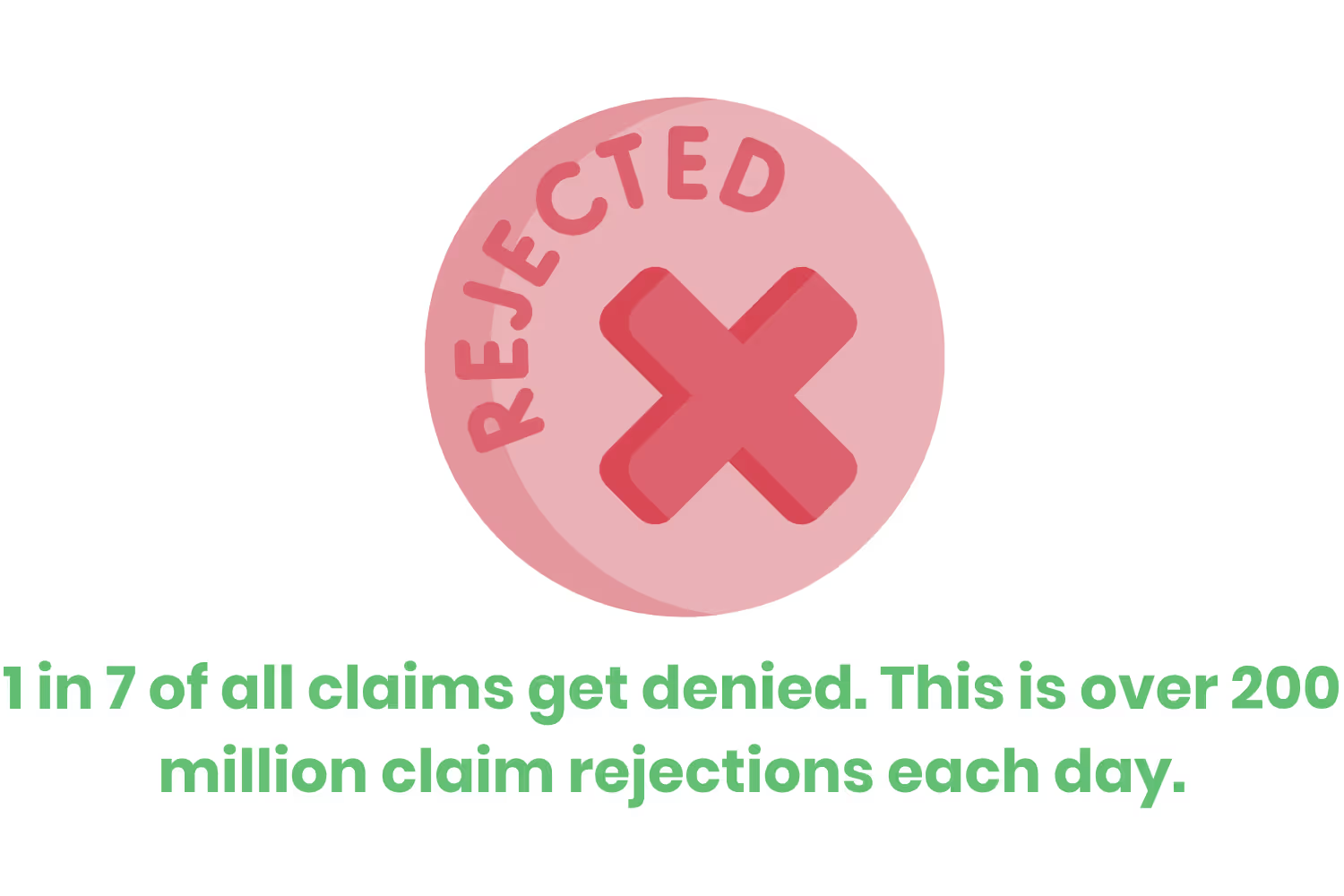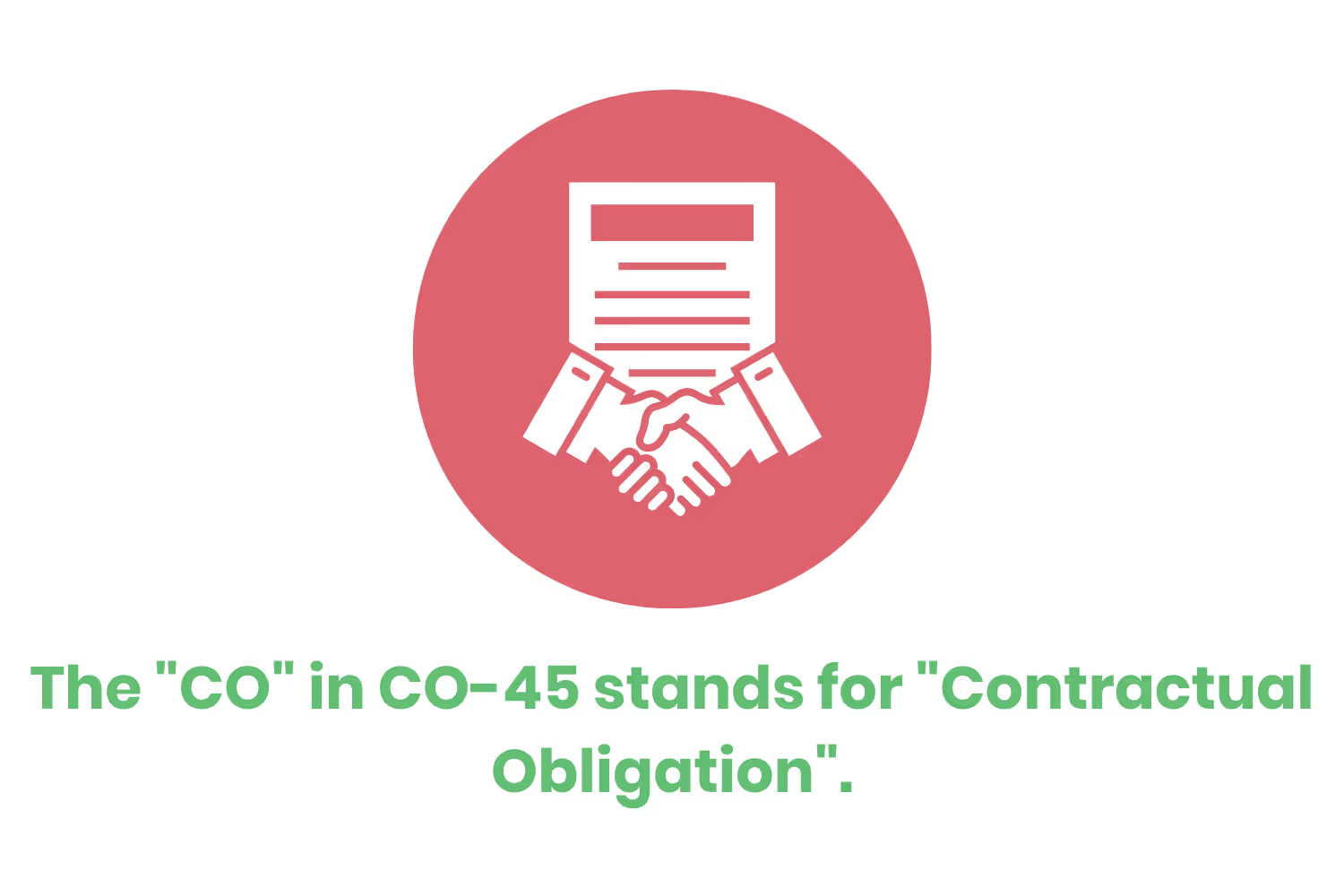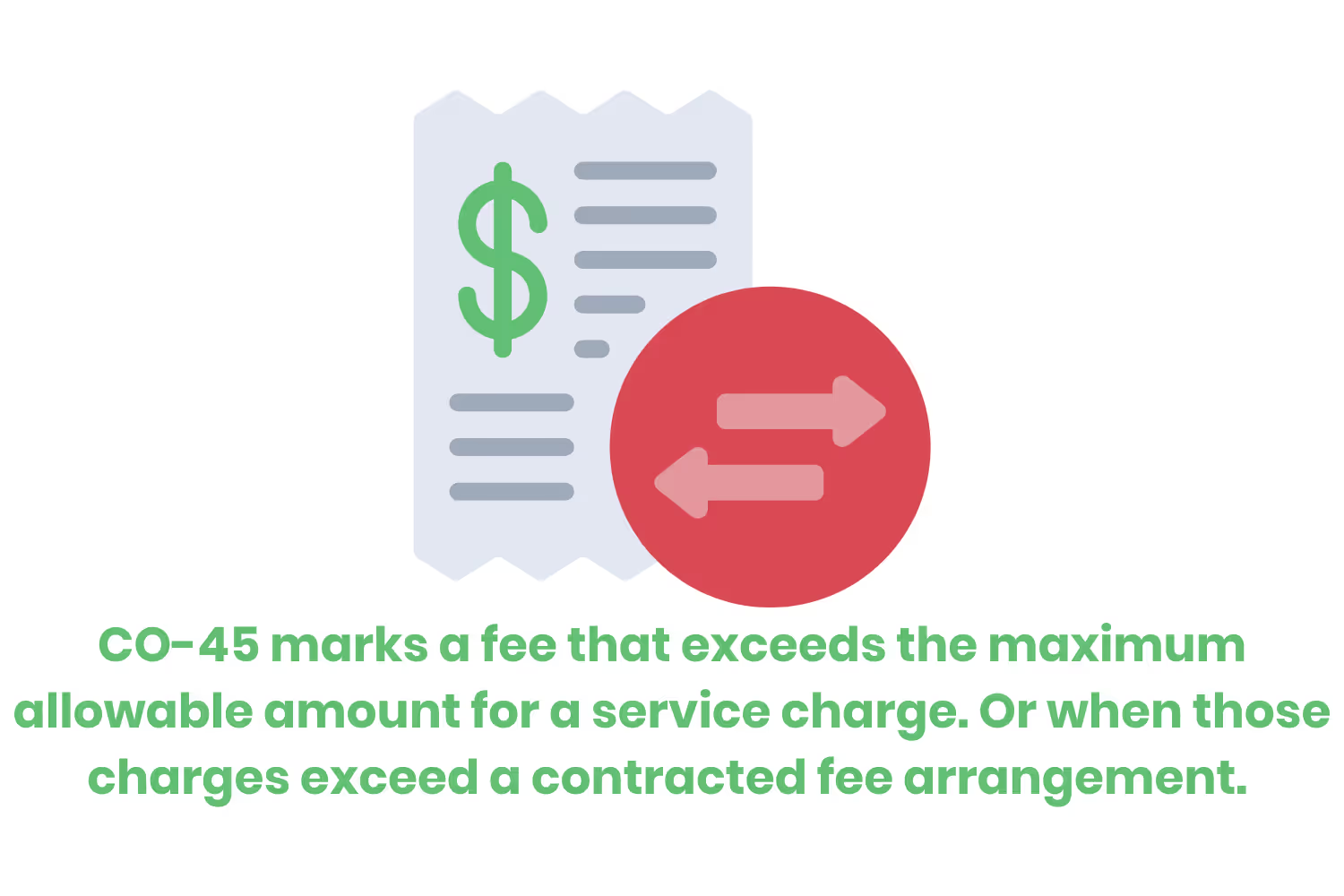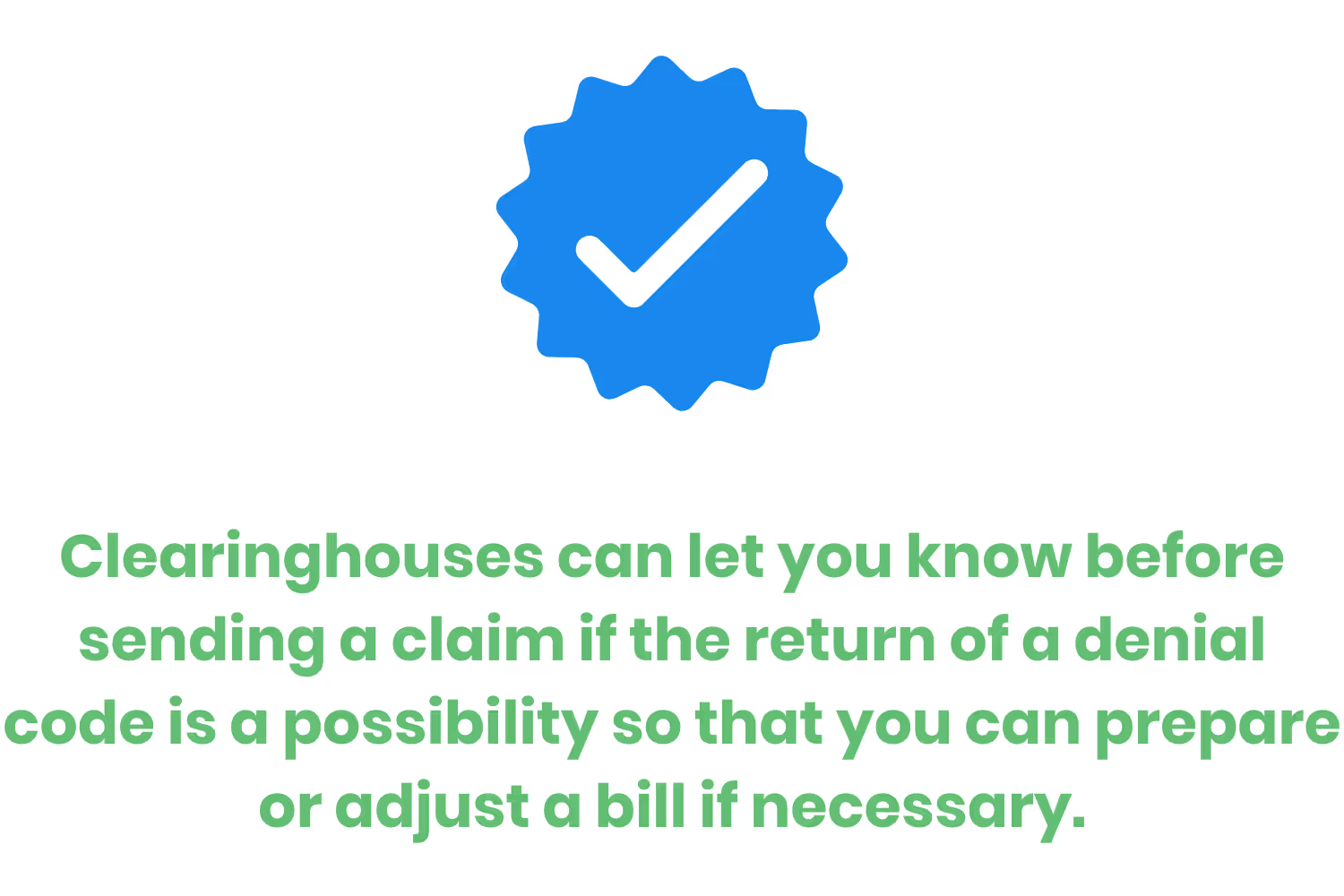Denial Code CO 45: What it is and How to Get Help
One common occurrence that we see healthcare organizations struggling with is CO-45. Let’s take a closer look at CO-45 including what it is, how to correct it and how to collect on it.

Nearly 15% of all claims get denied according to AARP. This amounts to over 200 million claim rejections each day!
Medical billing has plenty more disheartening statistics, but I’ll spare you on all of those for now.
But I do have some good news! There are ways you can avoid claim rejections and thus keep your revenue flowing.

Being in the medical billing field, you have to stay on your toes… but you already knew that. Knowing the different denial codes and what they stand for is just part of the equation. With our clearinghouse services, we regularly assist companies with managing the many parts of their billing ecosystem. From claim scrubbing to real-time alerts on denials so you don’t have to wait weeks on insurance companies.
One common occurrence that we see healthcare organizations struggling with is CO-45. Let’s take a closer look at CO-45 including what it is, how to correct it and how to collect on it.
What is a denial code?
Okay, so we have a code number. But for those who are just getting started in medical billing, let’s talk about denial codes. What even are they?
A denial code is a standard message that provides information about a claim that an insurance company cannot accept. Easy enough, right?
This code is part of a standard format that all insurance companies follow to lessen the burden on the medical provider. This is fortunate given there are hundreds of different reasons why a claim can’t proceed in the cycle.
But if you’re a seasoned medical biller, you know that managing your organization’s denials is a burden within itself.
Yet, there are a few essentials when it comes to having a proper claim denial management system. The first step is to understand the reason for the denial. When an insurance company sends back a claim, it will indicate the reason, or a claim adjustment reason code (CARCs).
As you can imagine, there are hundreds of different CARCs…which means that there are thousands of unique combinations.
What does "CO" mean?
Denial code CO-45 is an example of a claim adjustment reason code. This code got its start as early as 01/01/1995. The “CO” in this instance stands for “Contractual Obligation”. These contractual obligations stem from the valid contract held between healthcare providers and insurers.
A contract between these two entities can have a binding agreement between both parties on what services and prices they’ll cover.

In other words, it’s a reference to the difference between what the physician charges for a service and what the insurance plan allows according to the contract. This contract can include the rate, maximum number of hours, days, or units for a particular procedure.
There are a couple of reasons why a payer may use this kind of CARC code. First, a joint payer/payee agreement might result in an adjustment that the member isn’t responsible for. Or, the provider’s charge may exceed the customary amount for which a patient is responsible.
CO denials make it so providers cannot place financial responsibility on their patients or beneficiaries.
What is denial code CO 45?
CO 45 is different from other CARCs in that it can also be a part of group code PR, depending on liability.
“PR” stands for “Patient Responsibility”.
This group code is relevant when the adjustment represents an amount that’s the patient’s responsibility. It typically involves deductible and copay adjustments.
But I’m getting ahead of myself. For the sake of this blog, let’s focus on the CO group code.

To wrap this all up, what does denial code CO-45 mean? CO-45 marks a fee that exceeds the maximum allowable amount for a service charge. Or when those charges exceed a contracted fee arrangement.
This adjustment amount cannot equal the total service or claim charge amount. The adjustment must also not duplicate provider adjustment amounts from prior payer's decisions.
Examples Involving CO-45
I know I just threw a lot at you. With all of the different codes and terms, you may feel a little lost.
The good news is that CO-45 codes generally come in a paid claim. In other words, receiving them means that your organization received SOME money…just not its entirety.
To reiterate, this means when the claim processes there will be an amount that insurance can accept while the rest is a write-off.
To better illustrate this, here are a few examples of instances where CO-45 is the code to use.

Example 1
For example, if you send out a charge for $100 dollars and the insurance company only covers the service for $80, they may pay the claim.
If they do this they will then send you a return code of CO-45. In this case, you got paid. The payer is just letting you know what portion of the bill exceeds the amount in the insurance contract.
Example 2
Let’s say both parties, the insurance company and the provider, agree to make the max allowable fee for surgery $100. But for a post-surgery bill, the provider bills the insurer for $150.
The additional $50 will be a Contractual Obligation. $50 is a contractual adjustment that the provider needs to write-off. So, this contractual obligation assigns the financial responsibility to the provider.
In this case, the provider cannot bill patients for the adjustment amount.
Example 3
Let’s say that a physician’s charge amount adds up to $1000.
Out of this amount, the insurance approves $800 and pays $760 with $40 assigned as patient responsibility.
In this case, $200 should be a write-off per the CO-45 denial code from the insurance company. Payment posting will write-off the $200 and post the payment of $760. The balance of $40 is then the patient’s responsibility to pay, or the secondary insurance.
Example 4
The provider has sent the healthcare service charge amount of $200 to the insurance company. Out of that $200, insurance is able to pay up to $160 per the contract. Insurance has taken responsibility to pay for $140 with $20 patient responsibility.
Here, the write-off amount is $40, which signals the use of the CO 45 denial code. While posting this claim, the payment posting team will write-off $40 and post the payment of $140. The balance of $20 is then sent to the patient/secondary insurance.
Is there a better way to manage CO 45?
Medical billing and coding can be a source of anxiety for even the most senior billers. The profession takes quick thinking, decision-making, and quite frankly resilience.
Being aware of denials before it takes weeks for a payer to return them to you helps sharpen those skills. This makes medical billing less of a headache and streamlines the process without asking for you to do any additional work.
Luckily, not every claim that comes back from insurance organizations is unpaid. Some require fewer company resources but still need attention for handling write-offs and tasks like this. Denial code CO-45 thankfully falls under that category.

Clearinghouses can let you know before sending a claim if the return of a denial code is a possibility so that you can prepare or adjust a bill if necessary.
There are so many different codes and statuses that insurance utilize, why not leave that information to a third party to sort through?
This way you can continue with your billing duties and not have to face an enormous pile-up.
Trust me, you don’t want to wait until the end of the year to deal with your denials and write them all off at once. Not to mention, putting off denial management prolongs your company from collecting revenue!
Conclusion
If you haven’t picked up on my overt hints throughout this blog post, Etactics provides clearinghouse services. We’ve been in this business for well over 20 years now, which means we’ve helped our clients process billions of claims.
Naturally, that also means that our clients run into denials. What is one of the most common denial codes they run into? You guessed it; CO 45. Since our clients come across it so often, we figured that there had to be other organizations out there facing the same problem as well…which is why we wrote this blog post!
If you would like to have more information on how we help our clients with CO 45 and other common denial codes, reach out to us!
Emphasize your product's unique features or benefits to differentiate it from competitors
In nec dictum adipiscing pharetra enim etiam scelerisque dolor purus ipsum egestas cursus vulputate arcu egestas ut eu sed mollis consectetur mattis pharetra curabitur et maecenas in mattis fames consectetur ipsum quis risus mauris aliquam ornare nisl purus at ipsum nulla accumsan consectetur vestibulum suspendisse aliquam condimentum scelerisque lacinia pellentesque vestibulum condimentum turpis ligula pharetra dictum sapien facilisis sapien at sagittis et cursus congue.
- Pharetra curabitur et maecenas in mattis fames consectetur ipsum quis risus.
- Justo urna nisi auctor consequat consectetur dolor lectus blandit.
- Eget egestas volutpat lacinia vestibulum vitae mattis hendrerit.
- Ornare elit odio tellus orci bibendum dictum id sem congue enim amet diam.
Incorporate statistics or specific numbers to highlight the effectiveness or popularity of your offering
Convallis pellentesque ullamcorper sapien sed tristique fermentum proin amet quam tincidunt feugiat vitae neque quisque odio ut pellentesque ac mauris eget lectus. Pretium arcu turpis lacus sapien sit at eu sapien duis magna nunc nibh nam non ut nibh ultrices ultrices elementum egestas enim nisl sed cursus pellentesque sit dignissim enim euismod sit et convallis sed pelis viverra quam at nisl sit pharetra enim nisl nec vestibulum posuere in volutpat sed blandit neque risus.

Use time-sensitive language to encourage immediate action, such as "Limited Time Offer
Feugiat vitae neque quisque odio ut pellentesque ac mauris eget lectus. Pretium arcu turpis lacus sapien sit at eu sapien duis magna nunc nibh nam non ut nibh ultrices ultrices elementum egestas enim nisl sed cursus pellentesque sit dignissim enim euismod sit et convallis sed pelis viverra quam at nisl sit pharetra enim nisl nec vestibulum posuere in volutpat sed blandit neque risus.
- Pharetra curabitur et maecenas in mattis fames consectetur ipsum quis risus.
- Justo urna nisi auctor consequat consectetur dolor lectus blandit.
- Eget egestas volutpat lacinia vestibulum vitae mattis hendrerit.
- Ornare elit odio tellus orci bibendum dictum id sem congue enim amet diam.
Address customer pain points directly by showing how your product solves their problems
Feugiat vitae neque quisque odio ut pellentesque ac mauris eget lectus. Pretium arcu turpis lacus sapien sit at eu sapien duis magna nunc nibh nam non ut nibh ultrices ultrices elementum egestas enim nisl sed cursus pellentesque sit dignissim enim euismod sit et convallis sed pelis viverra quam at nisl sit pharetra enim nisl nec vestibulum posuere in volutpat sed blandit neque risus.
Vel etiam vel amet aenean eget in habitasse nunc duis tellus sem turpis risus aliquam ac volutpat tellus eu faucibus ullamcorper.
Tailor titles to your ideal customer segment using phrases like "Designed for Busy Professionals
Sed pretium id nibh id sit felis vitae volutpat volutpat adipiscing at sodales neque lectus mi phasellus commodo at elit suspendisse ornare faucibus lectus purus viverra in nec aliquet commodo et sed sed nisi tempor mi pellentesque arcu viverra pretium duis enim vulputate dignissim etiam ultrices vitae neque urna proin nibh diam turpis augue lacus.




